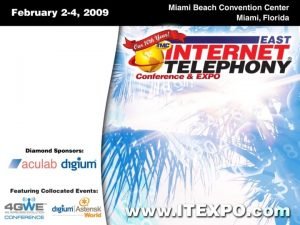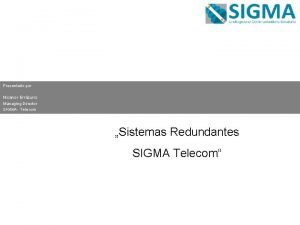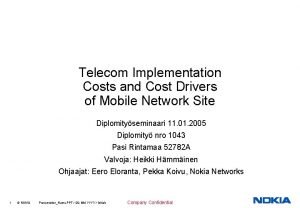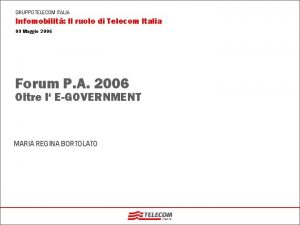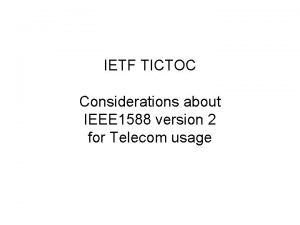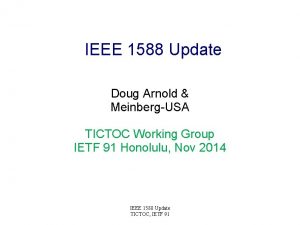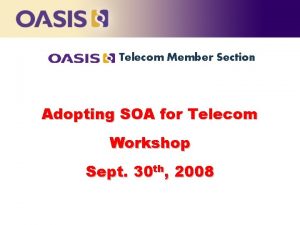1588 V 2 Telecom Profile Framework TICTOC WG




















- Slides: 20

1588 V 2 Telecom Profile Framework TICTOC WG, IETF 71 th Philadelphia, USA draft-ji-tictoc-1588 -telecom-profile-framework-01. txt Kuiwen Ji (jikuiwen@huawei. com) Xiaodong Duan (duanxiaodong@Chinamobile. com)

Agenda n Requirement n Interface n Modeling n Time Distribution

Requirement • There are various telecom applications that may potentially be supported by methods of timing distribution include frequency, phase and time synchronization. In this document we consider about phase or time synchronization (they may need frequency synchronization also). • Wireless - CDMA 2000 - UMTS TDD - TD-SCDMA - Wimax • Other domains - DVB, - IPTV - …………

Summarization Source from Cisco March 2007

Wireless Scenario Time serv Base

Note • The requirements listed above are applied to radio interface. When time or frequency reference is carried by the network, other requirements are applied. These depend on several factors such as Radio Base Station oscillator characteristics, filter capability of the Radio Base Station, etc. • As an example, frequency accuracy significantly better than 50 ppb may be required for the reference timing signal carried over the network in case of 50 ppb frequency accuracy requirement shall be fulfilled on the radio interface. • Similarly, in case accurate time and/or phase shall be distributed to the radio interface of Base Stations, the budget to be allocated to the network interface might be much smaller than the requirements defined by the wireless standards to be fulfilled on the radio interface. • These aspects are for further study. The thing we need to do is cooperation with these standard bodies to specify the phase/time requirement of Base Station network interface.

Agenda n Requirement n Interface n Modeling n Time Distribution

Two important interfaces Time serv Base

Interface type and performance • Type: - To transport time information, using the Ethernet interface like FE or GE using IEEE-1588 V 2 is a natural solution. - 2048 kbit/s or 1544 kbit/s interfaces defined in G. 703 have been use for a long time for transport frequency information in telecom. Is it necessary to define such a standard time interface? • Performance: - It's necessary to talk about the requirement of interface B with different wireless standard body. - Then we can specify the requirement of interface A. The budget between interface A and B is the specification for network equipments.

Agenda n Requirement n Interface n Modeling n Time Distribution

On-pass support -- BC • 'IEEE-1588 on-pass support' means that every node in the synchronization chain from master to slave (server to client) can support IEEE-1588. • For Boundary Clock (BC), the synchronization function providing filtering and maybe holdover within it must be able to recover time synchronization from master. Synchronization is transported one by one in a similar way to Synchronous Ethernet.

On-pass support – E 2 ETC • The End-to-End Transparent Clock (E 2 ETC) nodes need not synchronize to the master. They measure the residence time of PTP event messages and accumulate it in Correction Field.

On-pass support – P 2 PTC • Peer-To-Peer Transparent Clock (P 2 PTC) node computes link delay between two adjacent nodes in addition to residence time delay. Correction Field is updated for both residence time and link delay.

On-pass support -- parameters • Many parameters are required to be specified in a profile, a list of them is proposed, but it is certainly not yet exhaustive. - Size of the network (number of Nodes in a synchronization chain). - Characteristic of clocks (bandwidth, tolerance, noise generation, etc. ). - Types of IEEE-1588 -V 2 messages and packet rate. - Network Limits (see section 3. 2). - Availability of a master clock protection mechanism (see section 5). • Note: It has been mentioned 1588 can be used combined with Sync-E. In this case, the different parameters need to be considered.

No on-pass support • In case the intermediate nodes does not have IEEE-1588 support especially where legacy equipment is used, this is the only alternative to achieve time synchronization. • It's not necessary for the support of a network-wide 1588 reference. Therefore the performance is highly impacted by Packet Delay Variation in the network. In order to minimize the impact from the packet network, specific algorithms may need to be implemented at the slave side, depending on the required accuracy. Master Slaver Client Server PSN : time stamp

No on-pass support -- parameters • In this case, many parameters are required to be specified in a profile, a list of them is proposed, but it is certainly not yet exhaustive. - Size of the network and relevant PDV. - Characteristic of clocks (bandwidth, tolerance, noise generation, etc. ). - Types of 1588 V 2 messages and packet rate. - Network Limits (see section 3. 2). - Availability of a master clock protection mechanism (see section 5). • Note: 1588 relies on the symmetry of the network to recover To. D and/or phase, so in this case it may be difficult to meet the time/phase synchronization for wireless applications. • The support for synchronous Ethernet has to be considered as well. Synchronous Ethernet can be used to stabilize the local oscillator time base. In this case, the frequency is stable and IEEE-1588 is used only for To. D and/or phase.

Hybrid • Hybrid Networks represents networks where E 2 ETC and/or BC are used in conjunction with legacy equipments. It is a complex architecture. So we propose to study it later.

Agenda n Requirement n Interface n Modeling n Time Distribution

Time Distribution • Distribution mechanism is very important for network time synchronization. BMC introduced in the IEEEE-1588 V 2 is a solution. • RON Cohen's draft 'PTP over MPLS' is another good suggestion for time distribution in MPLS/IP network. • A list of aspects may be considered to specify a suitable telecom mechanism, but it is certainly not yet exhaustive. - Find the best grandmaster. - Calculating the traceability paths if possible and path selection. - Building a tree like distribution (prevent timing-loop any time). - Fast switching when failure occurs to maintain a degree of performance.

Next Steps • Update this draft base on comments receive from the group. • The content of this draft is within the charter of TICTOC WG, and it’s the fundamental of developing an IEEE 1588 V 2 profile , so we ask for the acceptance of this draft as a WG item.
 Conceptual framework vs theoretical framework
Conceptual framework vs theoretical framework Example of conceptual framework in accounting
Example of conceptual framework in accounting Theoretical framework
Theoretical framework Dispositional framework vs regulatory framework
Dispositional framework vs regulatory framework Dispositional framework vs regulatory framework
Dispositional framework vs regulatory framework Example of theoretical framework
Example of theoretical framework Telecom
Telecom Telecom expense reports
Telecom expense reports British telecom billing
British telecom billing Business class telecom
Business class telecom Sigma telecom
Sigma telecom Etisalat organizational chart
Etisalat organizational chart Scheda asgo
Scheda asgo Kustannusanalyysi
Kustannusanalyysi Oa imprese telecom italia
Oa imprese telecom italia Rajasthan telecom circle
Rajasthan telecom circle Jahid telecom
Jahid telecom Basic telecom terms
Basic telecom terms Telecom italia
Telecom italia Telecom management vendor
Telecom management vendor Bh telecom malta
Bh telecom malta







